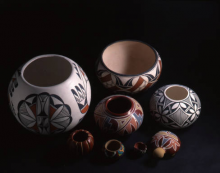Article
Jars, bowls, and other containers shaped out of ceramic material, such as earthenware (or clay), stoneware, and porcelain, which are subsequently fired, or super-heated. Subjecting pottery to heat initiates chemical changes in its ceramic material, including the removal of all water from the clay, which facilitates the hardening and strengthening of the earthenware form.
Historically, the Southwest is known for its centuries of pottery production, specifically earthenware forms finished with complex abstract animal figures and geometric symbols.
"Painted pottery," photograph by Eduardo Fuss. Eduardo Fuss Photograph Collection (2011-001-b30-f04-0005). Center for Southwest Research, University of New Mexico.
Manuscripts
References
Clemmer, Richard O.
1995 Roads in the Sky: The Hopi Indians in a Century of Change. Boulder: Westview Press.
Tschopik, Harry
1941 Navaho Pottery Making: An Inquiry into the Affinities of Navajo Painted Pottery. Cambridge: Peabody Museum of american Archaeology and Ethnology, Harvard University.
Wyckoff, Lydia L.
1990 Designs and factions: Politics, Religion, and Ceramics on the Hopi Third Mesa. Albuquerque: University of New Mexico Press.

